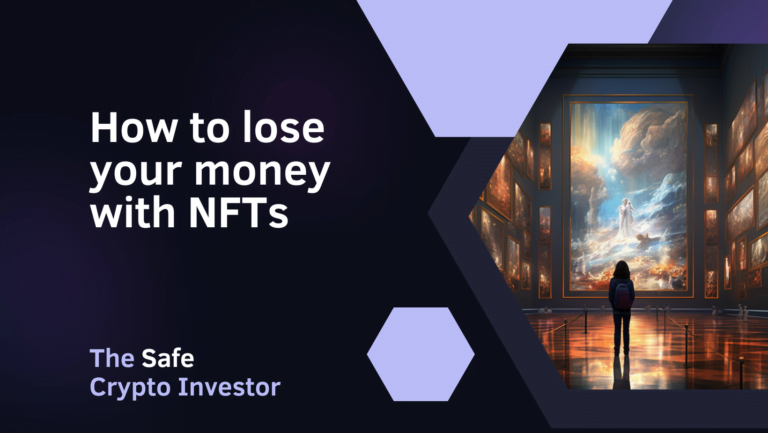Learn to
Do less and
Earn more
in crypto
Join the Safe Crypto Investor Newsletter today.
Every Sunday, you’ll get 1 actionable tip to:
- Automate
- Earn more
- Protect your crypto
Free Bonus
After you join, I’ll send you my Altcoin Red Flag Checklist (PDF) to prevent you from investing in scam projects.
The Blog
Your crypto journey starts here
Deep dives on crypto safety, automation, and investing.

Investing in a project without a team is risky
This newsletter will focus on a quick and easy way to protect you from investing in projects that will scam you: researching the team members.

3 Red Flags in a Crypto Whitepaper
Many crypto projects aren’t worth your money. They are not made for investors
but for the coin’s creators. To make them rich and move your hard-earned money
to their crypto wallet.

3 habits that will help you win in this bull market
We all want to win in crypto. A lot can happen between investing and results. Building good, solid habits is the key to winning in crypto.

5 steps to invest stress free in crypto
This letter is for those who want to invest in crypto efficiently and stress-free.
Many crypto investors are mentally exhausted and keep investing even when they have no money to do so (even in a bull run). That’s where the big mistakes happen.

How to get better at long-term investing
I changed my mindset from short-term gains to long-term investing.
A short-term goal is to make as much money as possible with big risks.
A long-term goal is to get a good return on your investment with as little risk as possible.

How to earn crypto in less time
To be profitable, do you need to spend 10 hours a week in crypto?
If you spend more time in crypto, will you earn more money?
The answer to these questions is as short as it is simple.
No.
Many people lose money in crypto because they are doing too much.
They are overworking.

Risk of lending money to buy more crypto
When I was 31, I experienced a massive loss in crypto. Crypto was in a full-on bull market. Everything pumped. Everybody was making massive amounts of money. I wanted

RWA is one of the biggest opportunities in the bull-market
I am always open to new things in crypto.

How to start investing in Crypto
Many people who start with crypto get overwhelmed by all the information. They
pick something random in crypto and go for it.

Do we trust Ledger Recover?
Today I will closely examine some strong opinions about Ledger’s new feature, Ledger Recover. I will strip down the complexities, address the panic, and ultimately ask: can we trust Ledger Recover?

How to lose your money with NFTs
Today, I want to get specific with NFTs (Non-Fungible Tokens). I will show you
exactly how people mess up with NFTs, losing their hard-earned money.

Is one layer of protection enough?
Many people that invest in crypto believe that only a strong password is enough to protect their crypto assets. This belief is untrue and can be devastating.

What can you learn from the FTX crash?
The FTX crypto exchange collapsed. Sam Bankman-Fried (owner of FTX) was overleveraged, and everything went wrong. It all started on Nov. 6, 2023. CZ, the owner of Binance, sold all

How to do macro technical analysis
You want to invest in crypto and get some juicy gains, and you have a list of altcoins you are interested in. You did fundamental research, and you know that

The worst ways people scam you
We all want to win in Crypto. We want to live our lives to the fullest. We want to build wealth for generations. Unfortunately, some people want you to lose.

Why investing in an Initial Coin Offering is a bad idea
I invested a small amount of money in an Initial Coin Offering (ICO). The top was 5 dollars in 2021, and now it’s worth 5 cents. Crypto was in a

What are the most secure Crypto wallets?
You earned a lot of wealth in a bull run and stored it in a wallet. One day you open your wallet to check if it is all still there.

Is buying the top a mistake?
I bought the top in December 2017, and that was a mistake. Bitcoin price was then almost 20k, and it fell like a rock, and I sold with a loss.

5 Tools to protect your crypto today
5 Tools to protect your crypto today To protect your crypto, you will need a handful of tools. My name is Daniel Donselaar. I first started investing in crypto in

How to set up a diverse crypto portfolio
How set up a diverse crypto portfolio Today I am going to teach you how to create a diverse portfolio. By creating a diverse portfolio you reduce risk, emotions and

What are you risking with your crypto on the exchange?
If you want to protect your crypto assets then you need to find a way to use the crypto exchange safely.
Featured wallets




Earn more crypto
Automate your investments
Protect your wealth against hackers
Subscribe to begin
Featured exchanges




Learn how to protect yourself
Keep your coins on the exchange
Get a free guide with 5 basic steps to start help you protect your crypto today.
Keep your coins on the exchange
Get a free guide with 5 basic steps to start help you protect your crypto today.
Keep your coins on the exchange
Get a free guide with 5 basic steps to start help you protect your crypto today.


